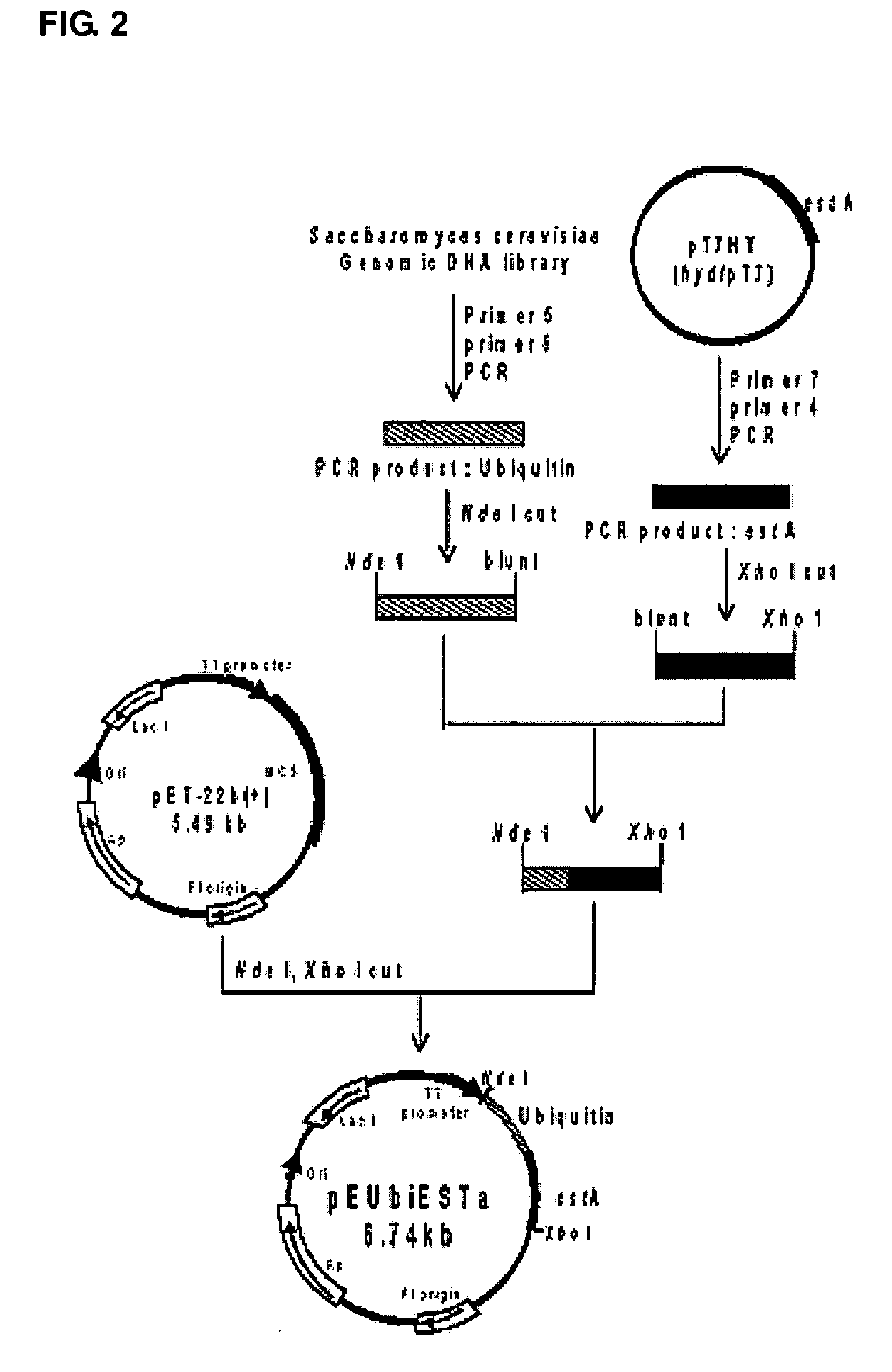Esterase, its DNA, its overexpression and production of optically active aryl propionic acids using the same
- Summary
- Abstract
- Description
- Claims
- Application Information
AI Technical Summary
Benefits of technology
Problems solved by technology
Method used
Image
Examples
preparation example
Preparation of Racemic Profen Ethyl Ester
[0027]Racemic profen (30 g) and ethanol (100 mL) were mixed and reacted in the presence of hydrosulfuric acid (2.5 mL) at 90° C. for 5 hours. The unreacted ethanol was removed by evaporation under the pressure. The reaction mixture was extracted with 1 M sodium bicarbonate solution three times to obtain racemic profen ethyl ester.
[0028]Conversion(%)=Conc.of(S)-arylpropionicacid+Conc.of(R)-arylpropionicacidConc.ofarylpropionicester×100Equation1Enantiomericexcess(%)=Conc.of(S)-arylpropionicacid-Conc.of(R)-arylpropionicacidConc.of(S)-arylpropionicacid+Conc.of(R)-arylpropionicacid×100Equation2
example 1
Sequence Analysis of a Novel Esterase Gene
[0029]Chromosomal DNA isolated from Pseudomonas sp. BHY-1 was partially digested with Sau3A, ligated with BamHI-digested pUC119 vector and then was transformed into E. coli DH5α. One of the clones, carrying a plasmid named as pT7HY (about 3 kb), exhibited enzymatic activity producing (S)-ketoprofen from (R, S)-ketoprofen ester and was chosen for further study. And also, the results showed that the novel esterase gene has a molecular weight of about 41 kDa. Transformants were selected based on a tributyrin hydrolysis as well as a stereoselectivity towards ketoprofen ester. The results showed that the novel esterase gene has a molecular weight of about 41 kDa and consists of 1,143 bp nucleotides (381 amino acids). The gene was registered in Genbank of NCBI and was assigned the Reg. No. AF380303 but has not been published yet. The novel esterase is identified by the SEQ. ID. NO: 1 for its gene and the SEQ. ID. NO: 2 for its amino acid sequence....
example 2
Construction of an Expression Vector for a Novel Esterase Gene
[0030]Chromosomal DNA isolated from Pseudomonas sp. BHY-1 was partially digested with Sau3A, ligated with BamHI-digested pUC119 vector and then transformed into E. coli DH5α. One of the clones, carrying a plasmid named as pT7HY (about 3 kb), exhibited enzymatic activity producing (S)-ketoprofen from (R, S)-ketoprofen ester. The novel estererase cDNA coding sequence was amplified by PCR using pT7HY as a template. The primers used in the above PCR are as follows.
[0031]
N-terminal primer[SEQ. ID. NO: 3]5′-GGG AAT TTC CAT ATG CAG ATTCAG GGA CAT TAC GAG CTT CAA TTC-3′C-terminal primer[SEQ. ID. NO: 4]5′-CCG CTC GAG TTA CAG ACA AGT GGCTAG TAC CCG CGC CAG-3′
[0032]The N-terminal primer was introduced with an NdeI restriction site and also ATG was introduced as an initiation codon in place of GTG, whereas the C-terminal primer was introduced with an XhoI restriction site. The product with a size of about 1,100 bp obtained from the a...
PUM
 Login to View More
Login to View More Abstract
Description
Claims
Application Information
 Login to View More
Login to View More - R&D
- Intellectual Property
- Life Sciences
- Materials
- Tech Scout
- Unparalleled Data Quality
- Higher Quality Content
- 60% Fewer Hallucinations
Browse by: Latest US Patents, China's latest patents, Technical Efficacy Thesaurus, Application Domain, Technology Topic, Popular Technical Reports.
© 2025 PatSnap. All rights reserved.Legal|Privacy policy|Modern Slavery Act Transparency Statement|Sitemap|About US| Contact US: help@patsnap.com



